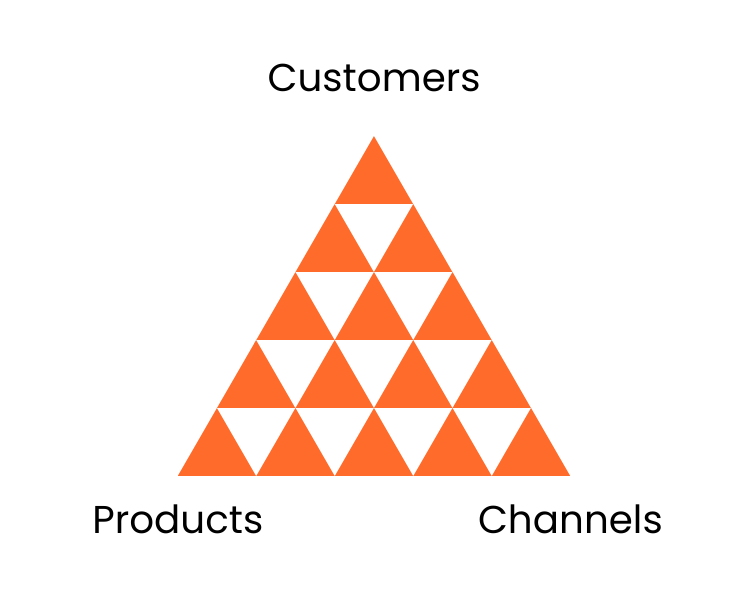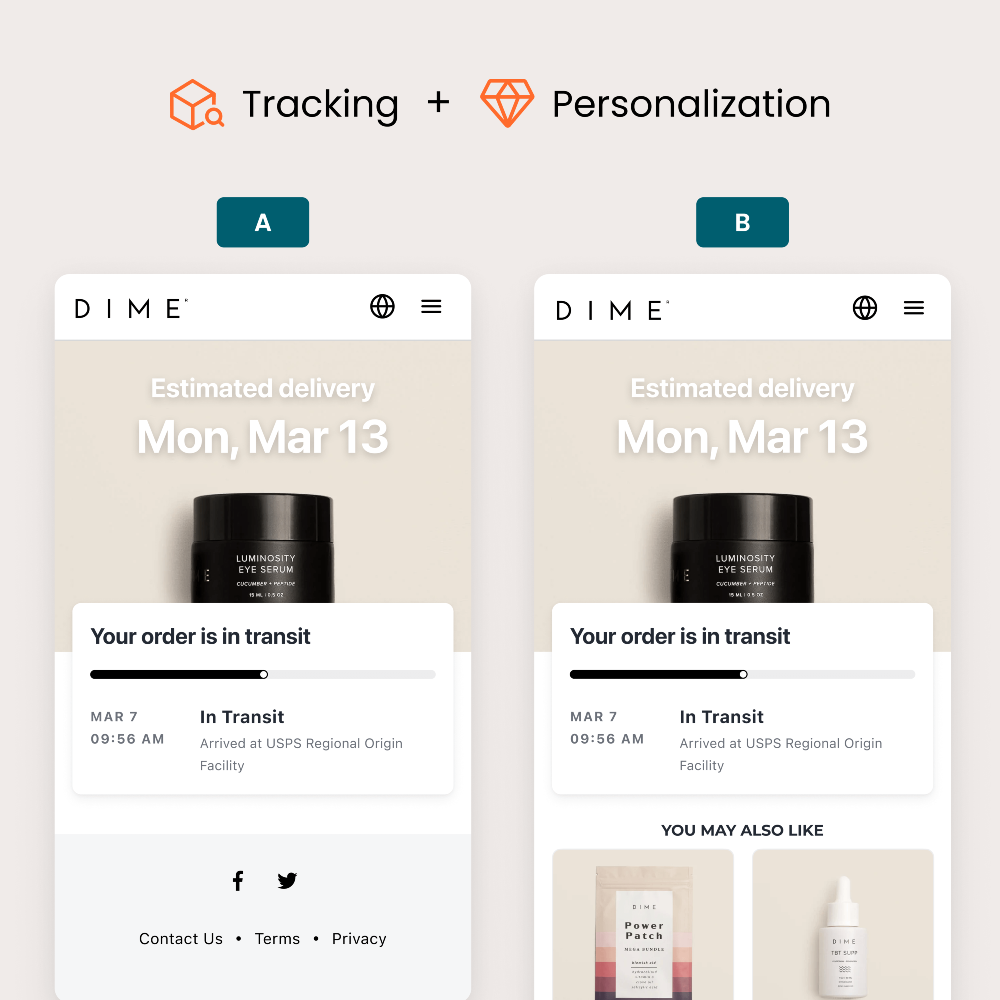eCommerce Marketing Essentials: Everything You Need to Get Started

If you're just jumping on the eCommerce wagon, we have some good news... and we have some bad news.
The good news is that selling online has never been easier.
What was once the Wild West of marketing has been thoroughly tamed. The tools and tactics at your disposal mean you can launch an eComm business in an afternoon. And both consumer trust and the places you can reach potential customers are at an all-time high. There's a ton of room for growth, too, with the market value of global eCommerce forecasted to reach 6.6 trillion by 2029.
The bad news is, well, also that selling online has never been easier.
The competition is fierce, and many brands are already well-entrenched. Unless you've got a truly unique offering, chances are somebody else is already out there selling something similar. And unless you've got a lot of money to invest, somebody also likely has a bigger megaphone. There's plenty of room for your brand to make your mark, sure, but the cost of acquiring a customer has also increased by 222% in the last ten years (depending on who you ask).
In this landscape, it pays to approach marketing cautiously, strategically, and with an eye toward learning and adapting. This guide is all about that.
What is eCommerce marketing?
eCommerce marketing describes a series of practices for engaging people, bringing them to your website or online store, and converting them into customers. It can include the pre-purchase, checkout, and post-purchase experience—where your goal is to upsell, build brand loyalty, or bolster retention.
Today, buying can take place on your website, an online marketplace, or even directly in an app. eCommerce marketers need to have a thorough understanding of all transaction scenarios, as well as the pre-purchase and post-purchase experiences of potential customers.
Who’s this guide for?
This guide to eCommerce marketing is written with the beginner in mind, but it’s not the usual fluff you’ll find all over the net. Heck, we hope that seasoned eCommerce veterans might get inspiration to level up their game.
eCommerce Marketing in 2024
While the core of eCommerce marketing has remained the same in the past two decades, the methods we use to connect with potential customers and the tools we have at our disposal have all evolved significantly. Consumer buying habits have also changed, with higher expectations regarding the buying experience. These factors mean that your strategy also needs to be constantly evolving.
Recent trends in eCommerce marketing
- The rise of social commerce. Not long ago, the connection between social media and eCommerce was tenuous—except perhaps in China, where the pairing of the two has always been strong. This has changed over the past few years with the coming of social commerce to North America and Europe.
Using social media ads to drive prospects to a website or product page is nothing new. Today, however, platforms like TikTok Shop and Instagram Shopping allow people to check out directly from their app, often with a single click. This reduces friction during checkout and lets influencers promote products directly to their audience through authentic content.
Social commerce blurs lines between marketplaces like Amazon and Etsy and social media providers like Meta, X/Twitter, and TikTok. It will have a significant impact on eCommerce marketing in the future. - Omnichannel marketing. "Omnichannel" might sound like the latest buzzword—or something an evil corporation in a bad Hollywood movie might dream up as part of a secret plan to rule the world.
In reality, however, omnichannel is a strategy for ensuring consistency for buyers across the dozens of channels where they might encounter your brand. As competition has ramped up, hyper-focus on a single channel rarely pays off as well as it used to for established brands, nor does focusing solely on engaging customers.
Omnichannel marketing, specifically, implies taking a more holistic view of the channels where you could be selling—not necessarily spreading your efforts evenly across each one—and ensuring a customer-centric experience with your brand no matter where you appear. For retailers who do business online and offline, omnichannel also means ensuring people have an excellent experience whether they walk into a brick-and-mortar store or visit your website.
- Unified commerce. You can think of unified commerce as the other side of the omnichannel coin. As brands have started emphasizing consistent customer experiences across all channels, they've also learned the value of consistency across their back-end operations to provide the best service possible.
Unified commerce means bringing together all the processes along your supply chain. This can imply uniting aspects of its brand, product, fulfillment, analytics, customer service, and more. In the coming years, we expect to see online retailers reduce reliance on dozens of solutions that need to be revised in favor of building a well-connected tech platform that does everything for them.
It's a relatively new concept compared to these others, so read more about it here: Unified Commerce: The Key to Maximizing Efficiency, Visibility, and Loyalty. - A cookieless universe. Diminished support for cookies by tech companies like Google, Mozilla, and Apple has impacted attribution, remarketing, targeting, and personalization. (Google has delayed phasing out cookie support in Chrome until 2025 to better align with regulators in the UK, but the end is still very much nigh.)
Cookies once allowed websites to identify and track visitors across multiple sessions, ostensibly to enhance the user experience. However, the pendulum has shifted toward more anonymized data and user privacy protection. This shift has prompted the development of more privacy-focused technologies and strategies for tracking and personalizing the user experience without compromising individual privacy.
For eCommerce marketers, this change comes down to one thing: it's rapidly becoming much more challenging to target individuals or specific groups of people. Instead, there's a growing reliance on first-party data or attribution intelligence that leverages direct interactions and information shared willingly by users. This shift emphasizes the importance of building more robust, trust-based customer relationships. That's the way the cookie crumbles.
First Principles of eCommerce Marketing
When it comes to eCommerce marketing, there are many places you could begin or questions you could be answering—so many places, in fact, that even experienced teams can lose focus and spread themselves too thin in the early stages.
The deceptively simple triangle below contains the most significant elements you must consider to launch or grow a marketing campaign in the eComm space: customers, products, and channels. Of course, within it are dozens of considerations and decisions unique to your business. Taken as a whole, it also represents the point of convergence for your marketing strategy, where your customers' needs, the value of your products, and the strengths of your chosen channels intersect.

1. Understanding your customers
It all starts with your customers. After all, without them, where would you be?
Remarkably, many marketing teams have extremely limited face time with customers compared to frontline teams like sales or customer service. It's relatively rare that eCommerce businesses actually spend time understanding customer needs, whether they're trying to solve a problem or enhance their lives.
Take, for example, buyer personas. Simple buyer personas are sometimes criticized for being rooted in oversimplified stereotypes and ultimately not based on the reality of your customers. Ideal Customer Profiles (or ICPs) are often posed as an alternative path, but they can suffer from the same issues. You end up with abstract stereotypes of customers rather than a real understanding of their needs and concerns.
We can't stress this enough: talk to your customers. The key here is to base your personas or ICPs on authentic customer interactions and routinely validate and update them based on continued engagement.
Early on, you'll want to do market research to understand your target audience. Focus groups and surveys can also help you test messaging (at a high level) or even vet potential campaigns. (For instance, when deciding whether it's better to take a fear or value-based approach in your most recent campaign.) Talking to your customers ensures that your marketing strategies are well-informed and tailored to your audience, increasing the likelihood of their success.
If you already have a healthy customer base, consider establishing a customer advisory board (CAB) to provide ongoing feedback on everything you do. CABs are often used for product feedback but are also a great way of testing marketing messaging or generating ideas. Don't stack your CAB with your biggest fans—a CAB should provide you with a legitimate third-party perspective, including painful yet necessary criticisms from detractors.
Gathering Feedback
For eCommerce marketers, it's particularly important to time customer feedback correctly. Ask too soon, and your product may not have arrived. Ask too late, and the customer will ignore you. The crucial moment is post-purchase evaluation, when they're actively assessing their experience: about 1-3 after delivery, send a personalized email requesting feedback about the product, purchase, or post-purchase experience.
Of course, you can always use notifications or popups to get feedback on more immediate experiences, like the checkout flow, their experience on your website, or how they first heard of your product or brand.
Some of the questions you should ask of your customers are:
- How did they first hear about your product or service?
- How satisfied are they with your product or service?
- Why did they choose your product? Why did they choose your product over competing products?
- Does your pricing seem fair? Or are they feeling buyer's remorse?
- How was the checkout experience? How was their experience on your website or landing pages?
- If your brand involves a subscription service, ask customers who cancel why they decided to move on.
(Find additional questions here: What is Post-Purchase Evaluation?)
Beyond actively hitting the pavement or making some calls, most companies are also sitting on a wealth of data, including information stored in their CRMs, pulled from their website, social media, or online advertising analytics, or taken from other tools in their tech stack. Building an effective eCommerce marketing program means leveraging all of these sources of knowledge from the get-go.

2. Understanding your products
One of the biggest mistakes that eCommerce marketing teams make is relying too heavily on others within their organization as the be-all-end-all of product knowledge. Product marketing, for instance, is a specialty that's grown recently out of a specific need to bridge the gap between product development and revenue generation. They focus on the "product side" of the business, including messaging, positioning, and go-to-market planning. As a side effect, all other marketing tends to be consider "brand side."
But brand and product are intimately connected, and one always benefits from a deep understanding and alignment with the other. Ensuring that both product and brand messaging are harmonized enhances the overall market presence and significantly improves customer experience and loyalty.
In other words, the existence of product marketing and other internal SMEs (subject matter experts) shouldn’t let the rest of us off the hook. Know your product. Try your product. Your team should be intimately aware of (if not actively participating in) messaging and product nomenclature discussions, and they should have complete context on how and why these decisions are made. If messaging is being handed to you, raise your hand and ask about the why behind it.
Even if your specific marketing activities aren't immediately focused on your product, knowing the product will help you strategize. For instance, if your company sponsors a charity event or you're part of a team responsible for a campaign primarily in the "brand" space, a deeper understanding of the product will help you make explicit or implicit connections between who you are and what you sell. The tighter these connections for you, the easier it will be for customers to discern them, and the stronger the case for brand-focused activities will be in the first place.
3. Understanding your channels
Your customers and your products form two axes of your marketing strategy. The third axis is your marketing channels.
Agencies helpfully divide channels into three categories: paid (e.g., running ads), earned (e.g., press coverage, a YouTube video review of your product), and owned (e.g., your website or social media accounts) channels. They can also be further subdivided into digital versus traditional channels. These are all excellent ways of thinking about it.
Commonly mentioned marketing channels include:
- Social media. Facebook, LinkedIn, TikTok, X/Twitter. An effective way to engage customers and build community, though selling from organic posts can be challenging. (Paid social ads are a different story.)
- Email. Predicated on customers or prospects opting in, emails can be an effective channel for re-engaging people and letting them know about special offers.
- SEO. Search engine optimization, targeting keywords that are either of a commercial ("best summer shoes") or informational intent ("how do I kill stink bugs?"). Works hand-in-hand
- Events. Trade shows, launch parties, customer appreciation days, etc., all fall under the category of events. An excellent way to connect directly with potential customers.
- Digital ads. These can include PPC (pay-per-click) ads on search engines, various forms of social advertising, and sponsorships.
- TV and radio commercials. Traditional and often quite expensive, but still very effective for particular verticals and commonly used in brick-and-mortar retail.
- Direct mail. Direct mail can be a very effective selling channel, depending on your product and customers. Like email, it sometimes has a low reputation, but when done right, it can be quite successful. As a bonus, it's often easier to measure success with direct mail than other forms of traditional advertising.
- Referrals and affiliates. Having others sell for you can open up new audiences and markets, though sometimes it risks diluting your brand.
- Word-of-mouth. Thinking broadly, word-of-mouth might seem like a difficult channel to impact. However, loyalty programs (or simply delivering an excellent product and customer experience) can drive business via word-of-mouth. This can be as powerful as it sounds.
Focus channels can vary widely depending on your business model. For instance, if you're a DTC retailer, you may not have a brick-and-mortar presence. Or if you're strictly selling to other businesses (B2B), you may benefit more from a presence on LinkedIn and trade publications than on Instagram and full-page ads in Vogue. The point isn't necessarily to cover every possible touchpoint but to establish omnichannel consistency on those you do prioritize.
Remember also that every point of contact with prospects and customers counts as a potential channel. Think holistically about the customer journey, working cross-functionally with other teams like customer support, order fulfillment, and product development to ensure a seamless pre- and post-purchase experience. Unboxing, tracking notifications, and even processing returns may not sound like marketing channels, per se, but all benefit from consistent experience with your brand.

Bonus Tip: Scaling with confidence
Remember, omnichannel doesn't mean all channels, everywhere. It means taking a unified approach across all the channels you invest in, ensuring consistency. Starting out, it's usually better to focus on a few channels for advertising and selling. Your online storefront, for instance, should be a priority (in most cases).
Once you've built out the backbone of your market-facing operations, expanding becomes much easier, especially if you have the right tools. For instance, launching on TikTok Shop when you already have an eCommerce store can be made much easier by using an app like AfterShip Feed to sync inventory and workflow.
Why eCommerce Marketing is Important
If you've read this far, you probably have an inkling of why marketing is so vital to running a successful eCommerce business. For one thing, it allows you to reach a broader audience more efficiently than traditional retail methods. With billions of people accessing the internet daily, the potential market for any product or service is vast.
eCommerce marketing also levels the playing field, allowing small and medium-sized brands to compete with more giant corporations, thanks to the relatively democratic nature of digital channels. With the right strategies in place, you can achieve significant reach and visibility, attracting and retaining customers.
Finally, eCommerce marketing is essential because it supports business sustainability. Maintaining consumer engagement is crucial in a world where consumer preferences constantly evolve. eCommerce marketing helps merchants stay connected with their community, build brand loyalty, and drive repeat business.
Bonus Tip: Marketing as learning
Build optimization cycles into your marketing practice and stick to it, including time to reflect on and review process and performance. In the moment, documentation never feels like a priority, but strong marketing teams work toward learning and reproducibility in mind, which requires creating an institutional memory.
eCommerce marketers have tools to track user engagement, conversion rates, and customer behavior. This data is instrumental in making informed decisions, allowing businesses to refine their marketing strategies, improve product offerings, and enhance customer experiences.
eCommerce Marketing Examples
One of the best things you can do as an eCommerce marketer is to start collecting examples of campaigns that inspire you. When you see a slick piece of creative—whether in your vertical or not—take a screen grab and save it to your computer. Better yet, jot down a few notes. A well-built swipe file can feed into productive brainstorming and strategy sessions or inspire your team when you’re in a slump.
Here are three eCommerce marketing examples to get you started:
Example 1: Warby Parker
Warby Parker was an early darling of DTC in the 2010s, thanks to a disruptive business model and clever eCommerce marketing.
Taking on an established industry causing a lot of consumer pain, including a lack of digital purchase options and a single, monopolistic competitor (Luxottica) driving the prices of frames higher than necessary, Warby Parker promised customers to make it effortless to buy a high-quality pair of glasses at a fair price. Not surprisingly, Warby Parker was among the first to offer a unique try-on program that anticipated a significant pain point of online shopping: they ship customers multiple pairs of glasses to try on in their homes before deciding on a pair.

But intelligent decisions like these aren't the only reason for Warby Parker's colossal success. The company practices a value-driven, customer-centric marketing strategy. For instance, WP is known for its excellent cause marketing, aligning its values with customers by implementing socially responsible initiatives. Their "Buy a Pair, Give a Pair" program exemplifies this approach. For every pair of glasses sold, a pair is donated to someone in need, fostering a strong connection with their customer base through shared values and social impact.

Example 2: Harry's
Harry’s is a men’s grooming brand determined to differentiate itself from competitors by offering industry-leading products and fantastic customer service. (You can read, for example, how much effort they put into delivering a top-notch tracking experience for customers.)
Harry's is also known for its robust, customer-centric marketing. Sam Thomas Davies points out, for instance, that a big part of this success lies in its "scrappy underdog" story. This narrative, presented consistently across various channels and throughout the customer journey, helps Harry's position itself against "Big Razor," companies like Gilette that have long held a monopoly on the North American shaving market, and connect with customers frustrated with what they suggest are overly expensive and low-quality products.

Example 3: DIME Beauty
DIME Beauty has made its mark on the skincare world with exceptional branding and attention to detail in everything it does. It also understands one of the critical tenets of omnichannel marketing: that every customer touchpoint is an opportunity to build a stronger relationship and encourage more purchases. From acquisition to checkout and into the post-purchase experience, DIME Beauty has built an end-to-end customer journey to build loyalty and maximize revenue.
In 2023, for instance, the DIME team tackled the challenges of increased customer acquisition costs by enhancing their checkout flow with recommendations using AfterShip Personalization. This serves customers by providing them with a curated shopping experience, and it helps DIME directly by encouraging the purchase of additional items. As a result of this implementation, they've seen significant improvements in the cart, checkout, and post-purchase one-click upsell (OCU), including a 45% increase in average order value (AOV) overall.

Read more about DIME Beauty in our recent case study.

